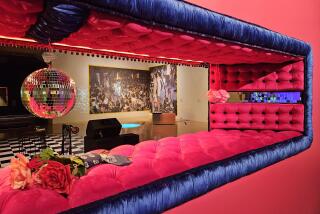ART REVIEWS : Close Encounters With Sculptures by Mark Lere
- Share via
Transforming the gallery into a suggestive, but always enigmatic narrative, Mark Lere’s latest sculptures at Margo Leavin Gallery make a game of reading visual language. Instead of cyclone stacks these are abstract objects haunted by vaguely familiar secrets. Some hint at figurative form, others at utilitarian objects like dumbbells, umbrellas or saddles. Still others recall Lere’s familiar mobius strip tea cups. They recycle their own emptiness. Hovering close to recognition, they all breed a certain cozy familiarity, but taken together they build toward an organic, vaguely ominous game of strangeness and manipulation.
Lere’s objects are refined, purist abstractions with possible philosophic or psychological underpinnings. They are also playful. Nearly all of the 19 pieces in this exhibit are made of a different material: cork, felt, bronze, aluminum, copper or cast rubber. Shifts in color, surface and weight coupled with wildly changing scale and construction techniques give each piece its own identity. It’s a fluid identity, however, as moving among the works seems to alter their meaning with each new perspective.
Lere has the ability to make an encounter with sculpture into a physical reality rife with intellectual ramifications. Although he strongly suggests the work of Barry Le Va, Lere has a more narrative agenda. Yet it is a narrative written in the observer as Lere crosses geometry’s pure reason with the unsettling openness of the unconscious.
Margo Leavin Gallery, 812 N. Robertson Blvd., to Nov. 10.
The Ticklish Edge: Megan Williams taps into a personal unconscious; something tantalizingly comic, enigmatic, even sexy. There is something genuinely appealing about the absurdity she pumps out in drawings, sculpture and installations even if the ideas do feel like they were inspired by Disney’s “Silly Symphony.” But as her drawings at the Santa Monica Museum of Art make clear, the cartoon quality is part of Williams’ underlying premise that art has a ticklish edge that borders on pure, sensual pleasure.
Most installations have a simple, good-time directness that is easy to absorb but lacks real depth. Whether that’s a result of editing for the exhibit or a reflection of the way the artist normally works is unclear. Books fluttering around a lectern like pigeons waiting for a handout or crisp white doors unfurling like snappy accordion pleated banners need more than surreal enigma and cursory nods to mystic number systems to give them unity or staying power. More interesting are the standardized female figures carved into a strip of rubber and the faceless Dutch bankers with floating hats that hint at issues of lost identity.
Thankfully, Williams’ sensuality comes through loud and clear in her spiraling “Systems to Measure / Three Dimensional Drawing.” This drawing in real space uses almost invisible monofilament to float silky white and jittery black lines into mysteriously unwinding linear cyclones. Tucked into the back of this all-white nook is a faint hail of broken lines that makes the entire sight even more a fantasy.
Santa Monica Museum of Art, 2437 Main St., to Nov. 25 .
Women of Color: The issue of identity, when you are “other” or “different,” makes “Image and Identity” at Laband Art Gallery a particularly valuable exhibition. These works by five Chicana artists present an honest and multileveled exploration of what it means to be a women of color in a white-dominanted society.
While tied in theme and timing to the “Chicano Art: Resistance and Affirmation, 1965-1985” show at UCLA this show strikes its own sparks because it focuses strictly on Chicana women and thereby ignites issues of sexual oppression within the Mexican-American culture. As vehicles for communication about the fears and longing that accompany racial stereotyping, Laura Aguilar’s altars are especially powerful pieces of personal narrative.
Her information, when coupled with Barbara Carrasco’s flat, graphic paintings in trendy colors, which deal with the conflicts of a light-skinned, green-eyed Mexican able to “pass” for white, begin to suggest the emotional depths of this cultural issue.
Diane Gamboa’s defiantly painted Aztecs-with-an-attitude are luscious yet repellent images of personal power buttressed by supernatural belief. The aggressive superstition they thrive on is nicely offset by the everyday normalcy of Dolores Guerrero Cruz’s homey interior scenes and Margaret Garcia’s portraits of dynamic Chicana women.
If Guerrero Cruz and Garcia’s colorful paintings appear less than Mexican that realization calls into question the stereotypes of the observer and drives home the realization that artists of every ethnic community must daily bump up against mental barriers to individual identity.
Laband Art Gallery, Loyola Marymount University, Loyola at 80th St., to Nov. 3.
Man and Bug: Doug Edge has always had a way with metaphor and a healthy respect for the vagaries of language. At Earl McGrath Gallery, he again takes on the human condition this time making an environmental point with a series of paintings that link mankind to insects. Though there is little new or even clever about Edge’s pictorial corollaries between ants and bees in “Ant Bee” he does get some mileage from the word play attached to a “Femme Fatale” praying mantis. His version of Franz Kafka’s famous story of a sleeping man transformed into a beetle is titled “Bed Bug.” Humanity has in the past been considered a plague on the planet but Edge’s analogies between junkies and ants milking beetles for chemical stimulants give that old saw a somewhat new inflection.
Earl McGrath Gallery, 454 N. Robertson Blvd., to Nov. 6.
More to Read
The biggest entertainment stories
Get our big stories about Hollywood, film, television, music, arts, culture and more right in your inbox as soon as they publish.
You may occasionally receive promotional content from the Los Angeles Times.










